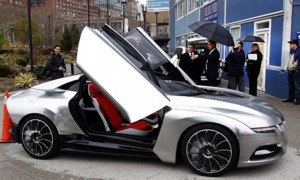The factory in Trollhattan stands idle but the bookkeepers and bankruptcy attorneys have been keeping busy in recent weeks trying to tally up the debts owed by the now-insolvent Saab Automobile and compare that to the company’s few remaining assets.
The math doesn’t work out well for those Saab owed money to. The final balance sheet shows assets of $532 million (3.6 billion Swedish kronor) but debts of $1.9 billion (13 billion kronor). It is possible that the tally will look more favorable, however, if the trustees overseeing Saab’s bankruptcy are able to find a buyer – with as many as seven bidders reportedly looking closely at the company.
Nonetheless, the bottom line isn’t a good one: a lot of folks looking to recover money from the doomed maker are likely to wind up with nothing. Among those least likely to come out whole are Saab’s Swedish employees. They actually pressed for the bankruptcy filing in hopes of recovering months of back pay. Those workers are owed $89 million.
General Motors, which sold Saab to Dutch-based Spyker Cars in early 2010, is also on the hook for about $107 million. But the biggest debtor is the Swedish government. Among other things, it agreed to back loans from the European Investment Bank that allowed Spyker to make the purchase. All told, the Swedish treasury is out $388 million.
Among other debtors are the various parts and component suppliers who decided to boycott Saab over back bills, last March, forcing a shutdown of the maker’s headquarters plans and ultimately triggering its collapse.
The only workers likely to get some back pay are those at Saab Automobile Powertrains, the trustees have said. The Swedish government may get a small fraction of what it was due. Preferential creditors holding securities are the most likely to recover any money at all.
Saab struggled for most of 2011 hoping to find a white knight to bail out the company. It lined up a series of deals with various potential partners, ranging from Russian oligarch Vladimir Antonov to three different Chinese car companies. In the end, the Chinese deals were scuttled by GM. The U.S. maker decided it did not want to provide assets – in the form of engines and intellectual property – that could be used by potential competitors in China, now its biggest global market.
Saab briefly went into the Swedish equivalent of America’s Chapter 11 last autumn but declared itself insolvent in December. Spyker – which renamed itself Swedish Automobiles – wrote off its entire investment in the maker.
Even so, the Saab story may yet play on. According to Swedish sources, at least six, and possibly seven different potential investors have been looking into purchasing the ashes of the automaker. They would almost certainly not be able to continue building the new 9-4X sport-utility vehicle and probably not the 9-5 sedan, either.
But Saab was developing an assortment of new products even as it started doing a corporate impression of the Titanic. It was near to completing work on an all-new 9-3 and was starting up other, even smaller models based on the Phoenix concept vehicle unveiled at the Geneva Motor Show a year ago.
Trustees aren’t saying where the bidding process stands – how many remain contenders or when a decision might be made.
Meanwhile, the Dutch parent headed by entrepreneur Victor Mueller is moving ahead on the revival of that country’s little sports car company – after renaming Swedish Automobile Spyker Cars.


“1.9 million” should read “1.9 billion”
Thanks, fixed…
Paul E.